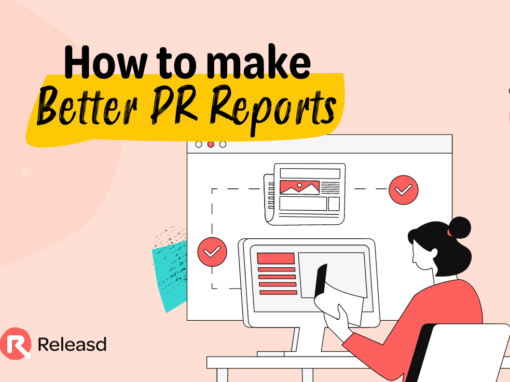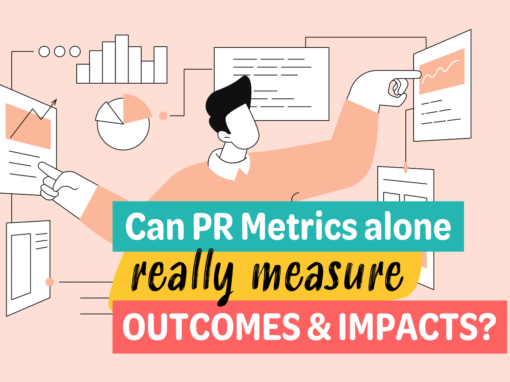Learning how to write a PR report is critical to client retention and internal stakeholder engagement.
Straight off the bat, here are a few key tips on how to write a PR report:
- Start strong with valuable data.
- Provide context and highlight future plans.
- Prioritise impactful KPIs.
- Offer an engaging format with clear navigation.
- Annotate key pieces of media coverage.
- Include social media highlights.
- Showcase successes and upcoming projects.
- Reflect on past activities and link to business goals.
When crafting a PR report, teams often forget about the importance of storytelling. It’s not just about sharing raw data or coverage metrics; it’s about weaving those numbers into a compelling narrative that truly illustrates the impact and value of PR efforts in driving business goals.
This narrative can better engage the reader and demonstrate the strategic role of PR. Without wasting any time, let’s take a look at how to write a PR report.
How To Write A PR Report (Must-Have Elements)
Hit The Ground Running
Grab attention from the outset. As PR practitioners, we are aware that our clients or executives may be pressed for time. Therefore, aim to kick-start a PR report with the most impactful coverage, key metrics, and notable campaign activities.
Provide Context
Continually contextualising and reinforcing objectives is essential for a well-rounded PR report. Teams should explain the significance of the coverage, how it fits into the grand scheme of things, and how certain PR activities or metrics exhibit value and progress.
Feature The Supporting Cast
When multiple projects or strategies are in the pipeline, make sure to discuss these in the report. This is especially crucial during slow news months; it provides an opportunity to elaborate on plans and how they align with the overarching campaign strategy.
A Picture Is Worth A Thousand Words
When crafting the visual presentation of the report, present a crystal-clear message to clients in an engaging way, steering well clear of low-grade screenshots and densely packed text. Aim for a smart, consistent design that speaks volumes about the team’s commitment to results.
Measure The Right Stuff
The temptation to include all possible metrics can be strong, but I firmly believe in focusing on the most relevant PR Key Performance Indicators (KPIs). Too many trivial data points can bombard the reader and weaken the strength of the metrics that genuinely count.
Make Navigation Effortless
Top-tier PR reports are logically structured and easy to navigate. The best PR reports incorporate a table of contents, which comes in handy, particularly when a client is short on time and unable to consume the report from start to finish.
Look into The Crystal Ball
Alongside breaking down what you’ve achieved, the best reports offer a forward-looking perspective, detailing how current activities are propelling the client toward broader objectives. Clients and executives need to understand what’s coming up next and how PR initiatives are bringing them closer to key milestones.
Choose The Right Report Format
Many PR teams are leveraging digital tools like Releasd to present their work in a format that is both clear and engaging. Using Releasd, PR teams can produce next-generation coverage reports that help busy clients and executives quickly digest key campaign information.
How To Structure A Monthly PR Report
Here’s my preferred layout for a monthly PR report:
Scene Setting: Introduction & Contents
I’d recommend setting the scene by outlining the work the team has accomplished. Include a few bullet-pointed highlights for quick consumption.
Laying Out The Numbers: Key Metrics
List a few clear KPIs that are not just comprehensible to the direct client but also to their internal stakeholders. In other words, break the KPIs down in layman’s terms.
Showcasing Our Success: Coverage Highlights
If the campaign has generated a lot of coverage, display the most impactful content first, with the rest following later. This ensures that the best coverage doesn’t get overlooked by busy clients and executives that only have time to skim-read through PR reports.
Winning On Social Platforms: Social Stats
Aim to include a few key social posts in the reports. I find that this context can be useful, especially for executives who might not fully grasp how social and PR interplay.
Driving The Message Home: Key Quotes
It’s always a good idea to showcase some key quotes within the main report. These can get extracted from coverage. Highlighting key quotes helps emphasise important points that might otherwise get lost, such as a certain perception that is successfully conveyed in the coverage.
Backing Up Our Work: Supporting Content
Make a point of mentioning press releases, reports, white papers, and other supporting collateral that underline the team’s valuable background work.
Looking Forward: Learnings & Next Steps
When wrapping up the report, it’s a good idea to provide a quick update on what’s coming next. This not only helps maintain momentum but also ensures alignment across all parties involved.
Celebrating Achievements: Highlight Reel
Recognising the value of celebrating victories, big or small, include a ‘Highlight Reel’ section. This section serves as a quick recap of our best moments, be it high-profile coverage, an influencer endorsement, or a successful social media campaign.
In The Pipeline: Upcoming Projects
Transparency is vital to build and maintain trust with clients. Hence, it’s worth including an ‘Upcoming Projects’ section. This should provide a brief description of what is planned for the immediate future. This helps the client understand the campaign strategy and can build enthusiasm around the next steps.
Taking Stock: Evaluation & Reflection
Reflection is an essential part of moving campaigns in the right direction. Set aside a portion of the report for ‘Evaluation and Reflection’. In this section, look back at the successes and challenges of the month, providing honest assessments and learnings that will guide future actions.
Connecting The Dots: Mapping PR Activities To Business Goals
To reinforce the value of the team’s PR efforts, make it a point to directly tie campaign activities to business goals in a dedicated section. This helps clients easily see how campaign work is contributing to their bottom line and puts the value of PR activities on full display.
Writing A PR Report (Closing Thoughts)
Using a carefully-crafted approach and structure, PR teams can provide comprehensive, easy-to-understand, and actionable PR reports. After all, the aim of these reports is not just to inform but to demonstrate the value of PR efforts and foster strong, strategic partnerships.
Interested in exploring Releasd’s next-generation coverage reporting tool?
Book a 15-minute demo with our team today.
You may also like:
Best PR Tool (Our 14 Online PR Tool Picks)
Public Relations Portfolio (Present The Perfect Portfolio)



